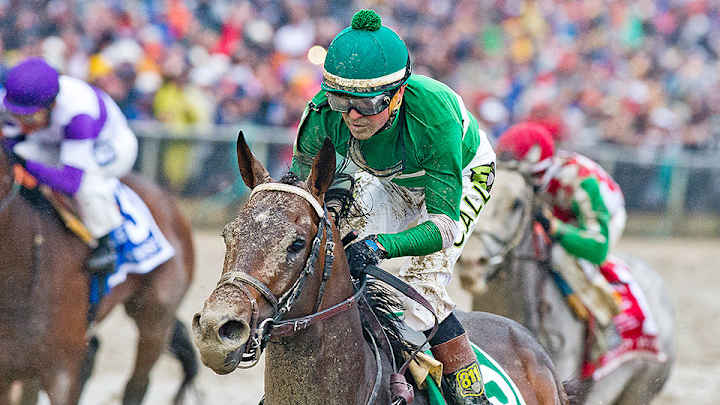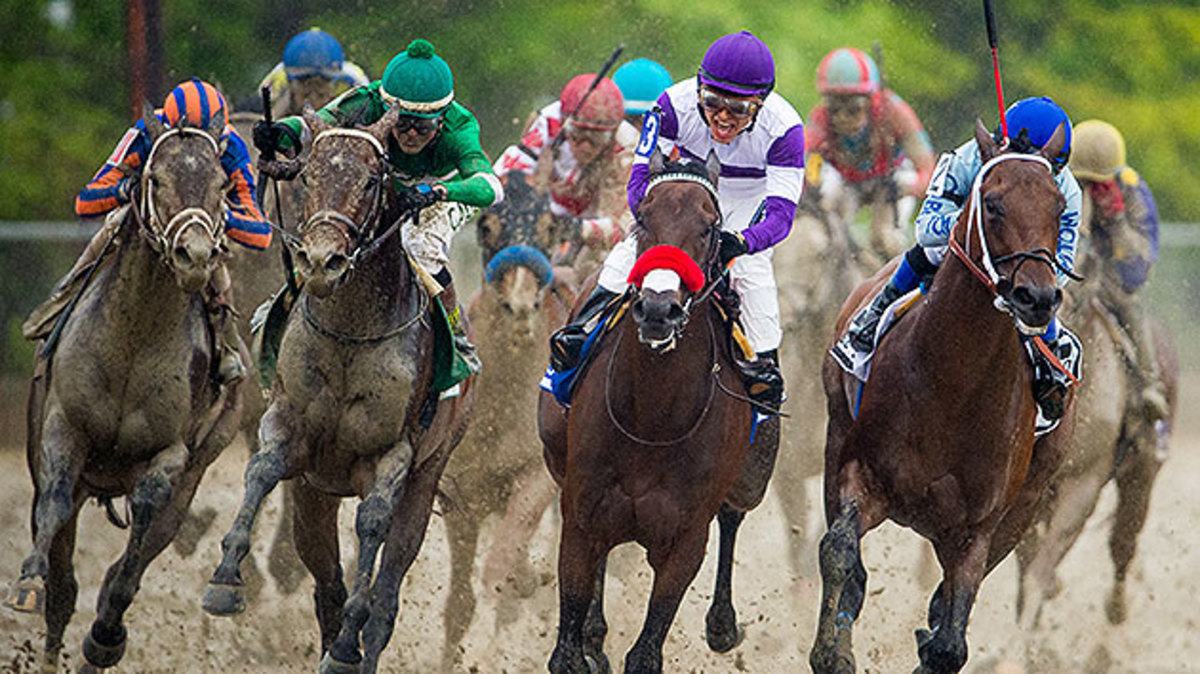Exaggerator spoils Triple Crown hopes with near-perfect Preakness run

Get all of Tim Layden’s columns as soon as they’re published. Download the new Sports Illustrated app (iOS or Android) and personalize your experience by following your favorite teams and SI writers.
BALTIMORE — A certain sense of order was restored to the racing game Saturday evening at Pimlico Race Track, in the rain and the fog and the bitter, cold wind and the deep, brown slop beneath the hooves of the racehorses. In the fortnight since an unbeaten colt named Nyquist had won the Kentucky Derby, just a year after the sport’s first Triple Crown in 37 years, an irresistible sense of destiny had swiftly taken hold, carelessly sweeping aside those long, painful years of learning, just because of one exception. Now that it has happened at last, seductive voices chirped—now that it has happened, it will happen again. And then perhaps again and again. It was as if a curse had been lifted and now we would be flooded with Triple Crown winners to make up for the torture of near misses and lost hope over all those years. This would be a new era.
It was all false and premature, hard lessons foolishly forgotten. The reminder came from Exaggerator, a late-running three-year-old colt who loves the mud like hay and oats, and the two Desormeaux brothers, sons of Louisiana: Hall of Fame jockey Kent, who rides with magic in his hands and a wild spirit in his heart, and workaday trainer Keith, who waited a quarter century to reach the top of the sport. Four times in 11 months, at three different racetracks, Exaggerator had lost to Nyquist, but in the 141st running of the Preakness, he exploded to the lead at the top of the stretch and finished 3 ½ lengths clear of runner-up Cherry Wine, with Nyquist another nose behind.
Exaggerator wins 2016 Preakness Stakes
In the aftermath, Nyquist’s preternaturally jovial trainer, Doug O’Neill, stood on the Pimlico track with mud cresting at his ankles and his thinning hair soaked and pinned to his skull. “It’s a bummer to lose,” said O’Neill. “I was visualizing Triple Crown kind of stuff.”
Five minutes earlier and no more than 50 feet away, trainer Bob Baffert had sought shelter from the rain that fell on Pimlico for most of the day and watched the race on a television monitor at the track’s indoor paddock. It was eerily similar to one year ago, when a thunderstorm hit Pimlico just before post time for the Preakness and Baffert watched in the same indoor paddock, on the same monitor, as American Pharoah splashed to an easy victory and headed to Belmont Park to make history. When the race ended, and Exaggerator was crowned, I suggested to Baffert that his place as the last Triple Crown trainer was safe for another year. Baffert shook his head, locked in a can’t-win proposition. “Ahhh, this would have been good for racing, too,” he said. “It would have been a good thing.”
It was a day of emotional swings for racing, not just in the Preakness, but throughout the day, a seven-hour reminder that racing can bring both breathtaking equine athleticism and sudden, gutting pain.
• Preakness Stakes winners: Full list of past champions of the race
In the very first race of the 14-race Preakness card, Homeboykris, a 9-year-old gelding who finished 16th in the 2010 Kentucky Derby, won for the 14th time in 63 lifetime starts. His photo was taken in the winner’s circle and moments later, he collapsed on the track and died. Track veterinarians suspected a cardiac event, but a necropsy will be performed. Three races later, Pramedya, a 4-year-old filly, broke one of her front legs approaching the homestretch of a 1 1/16-mile turf race and was euthanized on the track. In a twist of historical reality that almost defies belief, Pramedya was owned by Roy and Gretchen Jackson, the owners of Barbaro, who broke down in the Preakness 10 years ago.
Horse racing has been under intense pressure for the last several years to reduce the incidence of catastrophic breakdowns and has been generally successful. In 2009, the first year of data collection, horses at reporting tracks broke down at a rate of 2.00 times per 1,000 starts. Last year that number was 1.62. However, there is no escaping the reality that racehorses break down, and two deaths on the afternoon of a Triple Crown race, in front of a record attendance of 135,256 and an NBC television audience, will bring renewed—perhaps disproportionate—scrutiny. “This is such an unlucky coincidence that it happens on a day like today,” said Graham Motion, trainer of 2011 Kentucky Derby winner Animal Kingdom and a man respected for the exceptional injury record of his horses. “A horse having a heart attack like that, it’s one-in-I can’t imagine what. And then a horse breaking its leg on the turf…. [turf races are statistically safer than dirt races]. I can’t find the words to describe the statistical improbability.”
What did American Pharoah’s Triple Crown mean for racing?
It would be more than six hours after those deaths that the Preakness would go to post. The story line was as clear as in every Preakness: Can the Derby winner prevail? Nyquist, named for Detroit Red Wings’ Swedish winger Gustav Nyquist by Canadian, hockey-loving owner J. Paul Reddam, had not lost in eight lifetime starts. He had five Grade I victories on four racetracks and had been the sport’s champion 2-year-old. He seemed to be a superstar in waiting and was made the 3–5 morning line favorite (also his price at post time). Baffert, who sent longshot Collected to the post, summarized the feelings of many in the field when he said, “Why am I here? I figure if Nyquist happens to throw an interception, we want to be there to catch it. We’re looking for a turnover.”
One exception might have been Stradivari, who had started just three races, but had won the last two, against lesser competition, by more than 25 combined lengths. Somebody showed faith in him by placing an $80,000 win bet at neighboring Laurel Race Track early Saturday morning.
But the chief competition was Exaggerator, runner-up in the Kentucky Derby. On that day at Churchill Downs, Exaggerator came running down the stretch to pull within 1 ½ lengths of Nyquist. It was the closest Exaggerator had come to beating Nyquist in four races. And there was another factor: Exaggerator won the April 16 Santa Anita Derby prep race by 6 1/4 lengths on a sloppy track. Saturday’s rains made him even more dangerous.
Half an hour before the Preakness, O’Neill made the ceremonial walk from the Preakness Stakes barns, along a bark-chip path, to the racetrack for saddling. He walked alongside his nephew Patrick, a former football player at Brown University, and took pride in introducing him. Fans shouted at O’Neill and he shouted back. “Thank you, brother!” But O’Neill also knew that Nyquist was starting from the No. 3 post position, with relatively quick-starting horses inside and outside him. “It all comes down to the first part of the race, from the gate into the first turn,” O’Neill said, as he walked though the mud. “If Nyquist gets to the lead, or if he just gets clear running, we’re in good shape.”
Nyquist indeed broke sharply from the gate, but inside him, 35–1 shot Uncle Lino also came away running and the two horses went together into the first turn, with the surprising Awesome Speed, at 52–1 odds, also applying some pressure to Nyquist from the outside. It was not the scenario that O’Neill wanted. Even worse, the early pace was lighting fast: 22.38 seconds, the fastest first quarter in Preakness history. The pace slowed in the second quarter to 24.18 seconds, but neither Uncle Lino nor Awesome Speed gave way and let Nyquist run easily. “I never got a breather,” said Nyquist’s jockey, Mario Gutierrez. “But that’s horse racing."

Meanwhile, Exaggerator was running nearly a perfect race. Out of the gate, Kent Desormeaux steered Exaggerator almost directly left to the rail. “I wanted to strangle him when I saw him go to the rail,” said Keith Desormeaux, the trainer. “This is the only race he rode today and I was, like, all these other jockeys realize it’s a quagmire down there. And I’m like, ‘What’s he doing?’”
In fact, Kent Desormeaux said he had used the 12 minutes of warm-up time between the post parade and post time to measure the track in various places and decided that the rail was fastest. Kent Desormeaux, 46, has won three Kentucky Derbies, (now) three Preaknesses and three Breeders Cup races. He has also had at least three incidents involving alcohol use at the racetrack and is subject to regular breathalyzer testing. But there is no disputing his skill with reins between his fingers. In the Preakness, he used the length of the backstretch and into the final turn to push Exaggerator from eighth place to the hindquarters of the leaders, all without asking Exaggerator for his most explosive move.
American Pharoah, the Belmont and the making of a story for all time
Finally, just before the mile mark (the Preakness is 1 3/16 miles in length, 1/16 miles shorter than the Derby), Desormeaux gunned Exaggerator in front of the fading Stradivari and far to the outside. From there, he quickly swallowed Nyquist—“He just blew up and felt like King Kong,” said Kent Desormeaux—and opened up a short lead before dipping back to the rail and purposely throwing mud back at Nyquist and Gutierrez, aggressive and legal race-riding. Briefly, Nyquist responded, but then flattened out. Exaggerator held clear, and Desormeaux used the whip half a dozen times with each hand. Both horses were tiring badly; the final 3/16 miles were run in 20.12 seconds, a pace of more than 26 seconds for a quarter. The winning time of 1:58.31 was slightly faster than American Pharoah ran (while not being asked to run in the final stretch), but slower than any other Preakness for several decades, clearly owing to the heavy slop (which makes the fast first quarter even more impressive).
That early pace also took another toll. Uncle Lino, the speedball who had challenged Nyquist early in the race and deserves on assist on Exaggerator’s victory, finished seventh, roughly 20 lengths behind Exaggerator. After galloping out and then returning the homestretch, Uncle Lino stopped and was examined by veterinarians, before being put in a horse ambulance for precautionary reasons. “He was walking fine, jogging fine, bearing weight on all limbs,” said Keith Latson, on-call veterinarian at the track. “But they discovered that he had a little bit of inflammation in the left front tendon. So they decided to load him onto the ambulance and give him a ride back.”
So it was that moments after the Preakness, Doug O’Neill stood talking on the track with a small group of reporters about Nyquist’s loss, “He’s such an amazing horse,” O’Neill had said. “But they’re not machines.” Then O’Neill noticed movement nearby, and noise. “Uh-oh,” he shouted. “Here comes a horse…” And the big, white horse ambulance carrying Uncle Lino thundered past, splashing mud into the air, a metaphor for a tough sport, rolling by on four spinning wheels.
